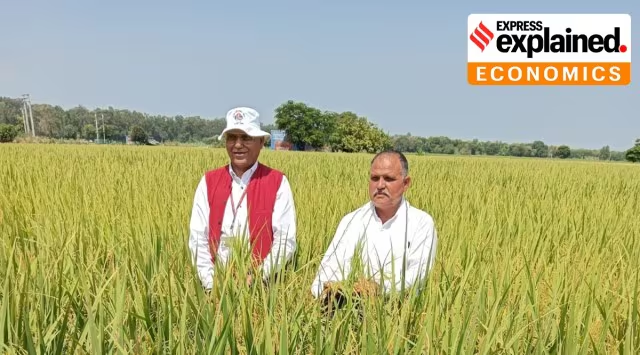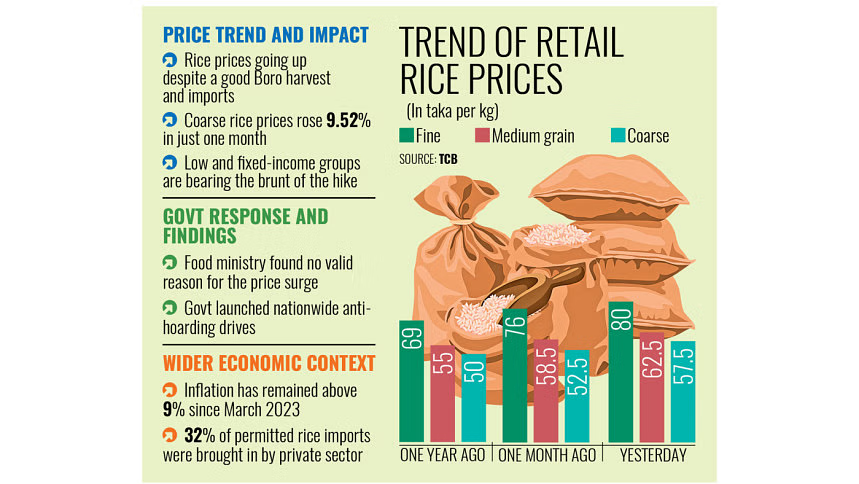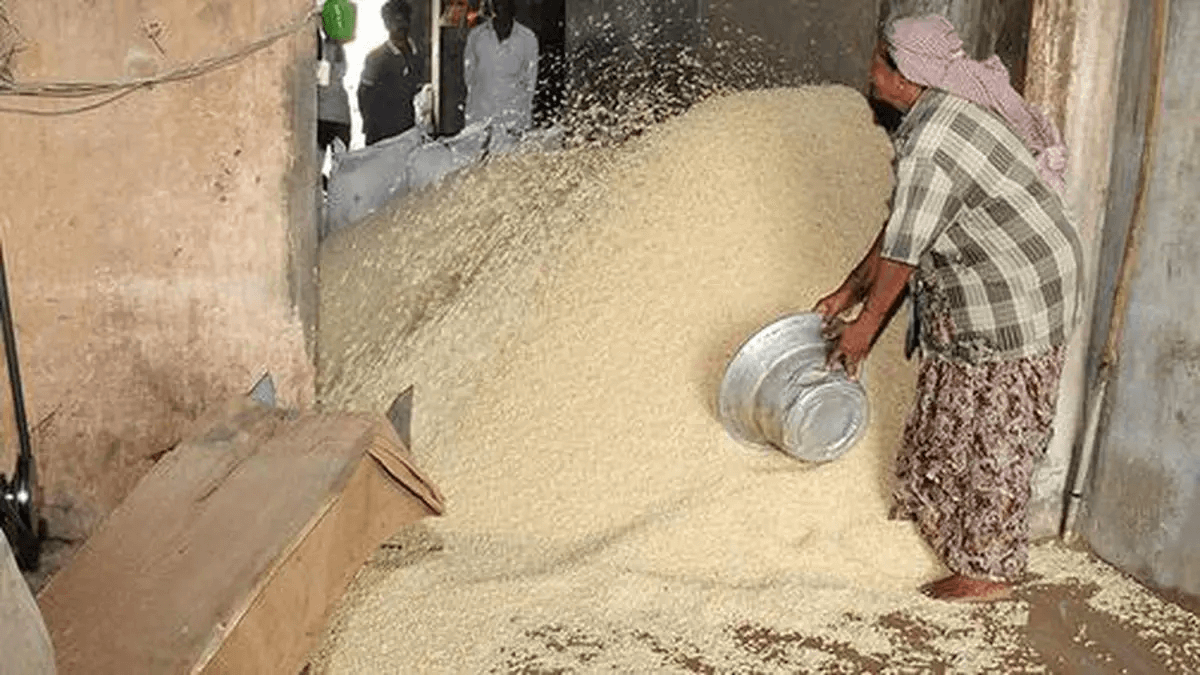Tags
Why Pakistan’s ‘piracy’ of Indian basmati rice varieties is concerning
Indian agricultural scientists and industry stakeholders have flagged the “illegal” cultivation of Indian Agricultural Research Institute’s improved basmati rice varieties in Pakistan. Here is why this is a problem.

IARI director AK Singh (left) with farmer Satyavan Sehrawat at his Pusa Basmati-1847 field in Delhi’s Daryapur Kalan village. (Express photo by Harish Damodaran)
Scientists at the Indian Agricultural Research Institute (IARI) and exporters have red-flagged the “illegal” cultivation of its improved basmati rice varieties in Pakistan. The issue came to the fore after the emergence of promotional YouTube videos, featuring recently-released IARI varieties, by Pakistani seed firms in places such as Multan, Bahawalnagar and Hafizabad.
Here is why this is a problem, and what India should do to address it.
But first, how have India’s basmati exports fared of late?
Quite well. India’s overall merchandise exports have dipped by 5%, from $372.1 billion in April-January 2022-23 to $353.6 billion in April-January 2023-24. So have agricultural produce exports, by 9.7%, from $43.4 billion to $39.2 billion for this corresponding period.
But the same period has been basmati rice exports bucking the trend and posting a 20.2% jump in dollar value and 12.3% in quantity terms. If current trends hold, the fiscal year ending March 2024 could see basmati shipments of close to 50 lakh tonnes (lt), valued at $5.5 billion (or Rs 45,550 crore). These would be all-time-highs.
Table 1 shows basmati exports booming even as export of non-basmati rice has slid. The current fiscal may end up with non-basmati rice exports of just under 110 lt worth $4.4 billion, way below the record 178 lt, and $6.4 billion achieved in 2022-23. This shouldn’t surprise, as the Centre has banned exports of all white non-basmati rice. Only parboiled non-basmati shipments are being permitted now, that too while being subjected to a 20% duty.
So, what exactly is the ‘neighbourhood threat’ that’s being talked about?
The threat relates to the alleged seed piracy and unlawful cultivation in Pakistan of improved high-yielding varieties of basmati rice developed by IARI.
| Table 2: Area planted under different basmati varieties in 2023 kharif season (In thousand hectares) | |||||
| PB-1121, PB-1718, PB-1885 | PB-1509, PB-1692, PB-1847 | PB-1, PB-6 | Traditional varieties* | TOTAL AREA** | |
| Punjab | 469.64 | 198.61 | 144.34 | – | 812.39 |
| Haryana | 478.15 | 196.44 | 99.95 | 13.51 | 787.60 |
| Uttar Pradesh | 25.68 | 249.79 | 6.27 | – | 461.74 |
| Jammu & Kashmir | 4.76 | – | – | 41.85 | 46.61 |
| Uttarakhand | 12.72 | 5.37 | – | 1.23 | 19.35 |
| Himachal Pradesh | – | 6.37 | – | 1.25 | 7.62 |
| TOTAL | 990.95 | 656.58 | 250.56 | 57.84 | 2135.31 |
| Note: *CSR-30, HBC-19 and Basmati-370; **Includes Sharbati and Sugandha. Source: Agricultural and Processed Food Products Export Development Authority. | |||||
The New Delhi-based institute’s varieties covered nearly 89% of India’s estimated 2.1 million hectares cultivating the aromatic cereal crop in the 2023 season (Table 2). Known by the Pusa Basmati (PB) label, these varieties also have an over-90% share of the country’s $5-5.5 billion annual basmati exports.
What is so special about the IARI-bred varieties?
Traditional tall basmati varieties — the likes of Taraori (HBC-19), Dehraduni (Type-3), CSR-30 and Basmati-370 — were low-yielding, producing barely 10 quintals of paddy (rice with husk) per acre over 155-160 days from nursery sowing to harvesting. IARI varieties, having shorter plant heights, yield more grain, and in less number of days.
The first IARI variety — PB-1, released for commercial cultivation in 1989 — yielded 25-26 quintals/acre and matured in 135-140 days.
PB-1121, released in 2003, yielded less (20-21 quintals) with slightly longer maturity (140-145 days). Its USP was the grain quality — an average kernel length of 8 mm (versus 7.2-7.4 mm for Taraori and PB-1) that elongated to 21.5 mm (versus 14-14.75 mm) on cooking.
This was followed by PB-6 (a cross of PB-1 and PB-1121, released in 2010) and PB-1509 (2013). The last one yielded as much as PB-1, but with a seed-to-grain duration of just 115-120 days. IARI subsequently also unveiled improved versions of PB-1121 (PB-1718 and PB-1885), PB-1509 (PB-1692 and PB-1847) and PB-6 (PB-1886), incorporating genes conferring resistance to bacterial blight and rice blast fungal disease.
PB-1121 was “released” in Pakistan in 2013 — as PK-1121 Aromatic variety, and marketed as Kainat 1121 Basmati (‘Kainat’ being Urdu for ‘cosmos’). PB-1509 was, likewise, registered and renamed as Kissan Basmati in 2016. More recent are YouTube videos of Pakistani seed companies and so-called research farms and agro consultants, discussing new IARI varieties — including PB-1847, PB-1885 and PB-1886, which were notified under India’s Seeds Act only in January 2022. It is the surfacing of these videos that alerted the authorities in India, especially IARI scientists.
Is this concerning?
On the face of it, not much. Pakistan’s basmati exports fell from 7.58 lt (valued at $694.55 million) in 2021-22 to 5.95 lt ($650.42 million) in 2022-23. Although exports during July-February 2023-24, at 4.72 lt ($539.43 million), were higher compared to 3.66 lt ($386.88 million) in July-February 2022-23, the numbers are a fraction of India’s.
That said, India still has multiple reasons to be concerned.
To start with, basmati rice is grown only in India and Pakistan. Pakistan predominantly exports Super Basmati, a high-yielding variety (similar to IARI’s PB-1) bred by the Rice Research Institute at Kala Shah Kaku, near Lahore. This variety, released in 1996, has helped Pakistan gain a 66-70% share in the European Union-United Kingdom market for brown (unpolished/husked) basmati rice. That share has further gone up to 85% in the new marketing year from September 2023.
Moreover, while India is a clear market leader in Saudi Arabia, Iran, Iraq, United Arab Emirates and other West Asian countries, it has largely to do with consumer preference there for parboiled basmati rice. This rice — where paddy is soaked in water and partially boiled in the husk before milling — has harder grains, less susceptible to breakage after cooking for long than regular white rice. But with Pakistan mills increasingly adopting parboiling technology — and its farmers planting superior IARI basmati varieties — there could be challenges going forward.
A weak Pakistani currency (Rs 279 to the US dollar, against India’s Rs 83.5) only adds to its competitive advantage.
What should India do?
India enacted the Protection of Plant Varieties and Farmers’ Rights Act in 2001. The IARI-bred improved basmati varieties are all registered under this Act, which allows only Indian farmers to sow, save, re-sow, exchange, or share the seed/grain produced from them. However, even they cannot violate the rights of the breeder — in this case, IARI — by selling the seeds of the protected varieties in branded (packaged and labelled) form.
Moreover, the IARI varieties are notified under the Seeds Act, 1996, which allows their cultivation only in the officially demarcated Geographical Indication (GI) area of basmati rice within India. This covers seven states: Punjab, Haryana, Himachal Pradesh, Delhi, Uttarakhand, Uttar Pradesh (west) and two districts of Jammu & Kashmir (Jammu and Kathua).
The sale of seeds and cultivation of the above protected basmati varieties in Pakistan would arguably qualify as an intellectual property rights (IPR) violation, which India can raise in relevant bilateral forums and at the World Trade Organisation.
https://indianexpress.com/article/explained/explained-economics/pakistan-piracy-indian-basmati-rice-9230794/Published Date: March 24, 2024






